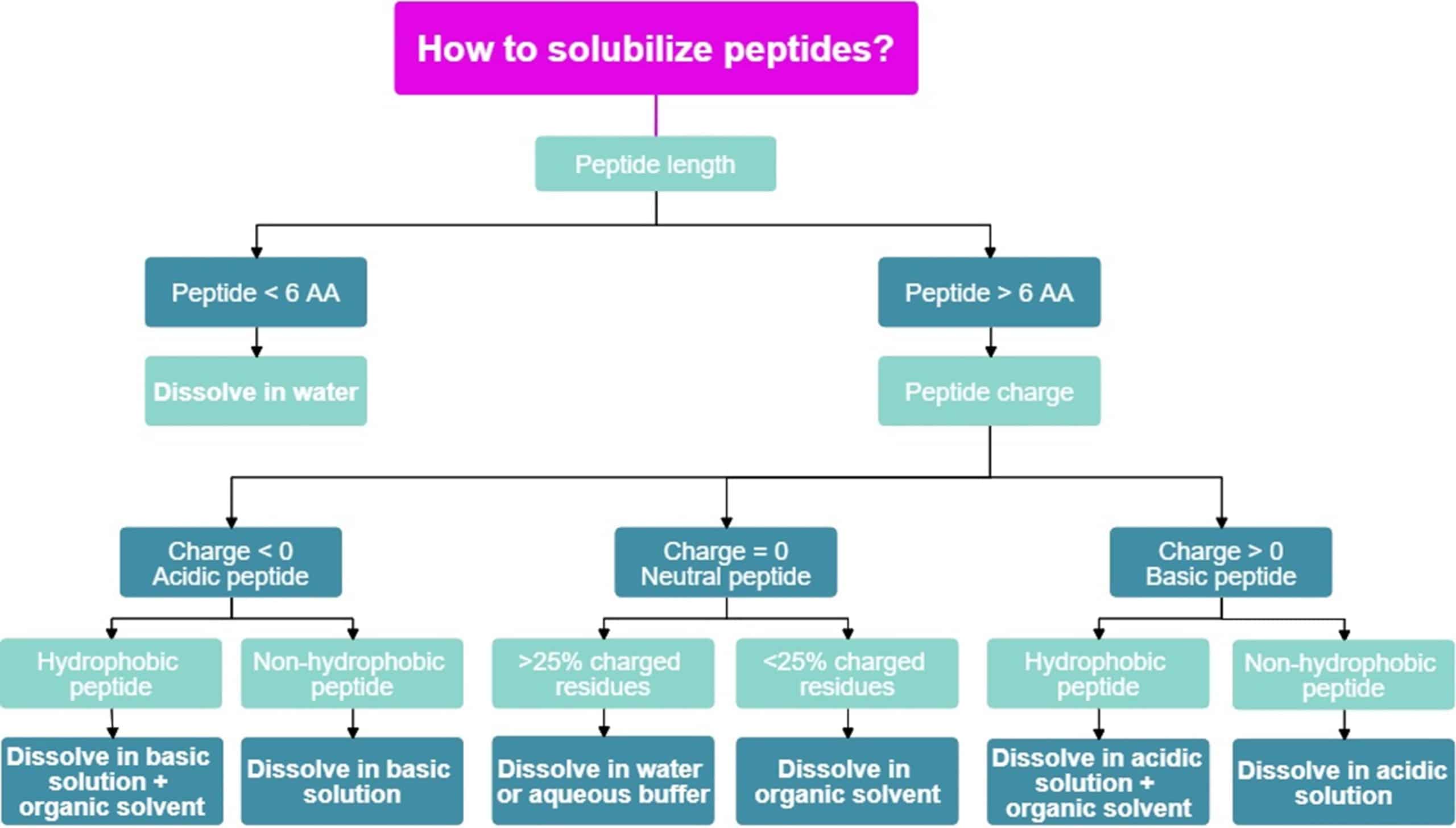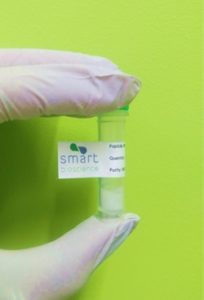Peptide synthesis
mg to multi-grams, +120 aa, cyclizations, fluorescence, biotinylation, heavy labeling…
Peptide libraries
96 well plates, 5µmol scale, 2 weeks, from 25€/peptide, various modifications
PNA synthesis
Up to 40 mers, CPP-conjugation, clickable PNA, fluorescent…
Express synthesis
SB-PEPTIDE offers a unique 10 days express peptide synthesis service.
Peptide solubility guidelines
SB-PEPTIDE’s custom synthesized peptides are delivered as lyophilized powder in 2 mL microtubes, that needs to be reconstituted. The solubilization is a critical step for a successful peptide assay. Improper peptide solubilization results in inaccurate peptide concentration, which can introduce experimental errors into data or lead to experimental failure. Finding the ideal solvent to dissolve your peptide is often a challenge. Even if the solubility of SB-PEPTIDE peptides is tested, the guidelines below may be helpful in preparing peptide solutions.
Ask now for your peptide solubility calculator by submitting a request through the form on the right side of the page. You will receive it by email.

General solubilization procedure
- Test peptide solubility using a small amount of the product, rather than the entire sample (Consideration to take into account when defining the quantity and the number of aliquots to order. We recommend to dedicate 1 aliquot tube of 1 mg for this purpose).
- Centrifuge to spin down any powder on the tube sidewall before use (10000xg for 5 min).
- Allow peptides to warm to room temperature before reconstituting.
- Use sterile and ideally oxygen-free water or buffer (Tris or phosphate, buffer at pH 7) when preparing peptide solutions.
- Briefly Sonicate the mixture to aid peptide dissolution (3x 10sec, ice between). Chill the tube on ice between sonications. Sonication improves solubility and minimizes peptide aggregation.
- If precipitation occurs, a gentle warming of the peptide solution would be helpful (Avoid excessive warming of the sample!).
- A peptide properly solubilized will result in a transparent, particule-free solution.
| Peptides are well solubilized if the resulting solution is transparent. On the contrary, it looks cloudy |  |
Peptide properties calculation & associated solubility
The amino acid composition can help predict the solubility of a peptide. Therefore, before choosing a solvent and dissolving the peptide, the sequence should be studied to determine whether the peptide is acid, basic or neutral:
- Assign a value of -1 to each acidic residue (D, E, and C-terminal COOH).
- Assign a value of +1 to each basic residue (K, R and the N-terminal NH2).
- Assign a value of +1 to each H residue at pH<6 and zero at pH >6.
- Count the total number of charges of the peptide at pH 7 (D, E, K, R, C-terminal COOH, and C-terminal NH2).
- Calculate the overall net charge of the peptide.
Charges < 0: Acidic peptide;Try to dissolve it in a basic solution by adding 10% NH4OH or ammonium bicarbonate in your buffer.
Charges > 0 : Basic peptide; Try to dissolve it in an acidic solution by adding 10% acetic acid, 0.1% TFA, 0,1% formic acid in your buffer.
Neutral peptide: if the peptide contains > 25% charged residues (e.g., D, K, R, H and E), it is generally soluble in water or aqueous buffers. Below 25% charged residues, it is recommended to use organic solvents (DMSO, ACN, DMF).
Oxidation sensitive peptides
Cys, Met or Trp-containing peptides are susceptible to oxidation. Therefore, it is recommended to dissolve them in oxygen-free buffers. Moreover, DMSO should be avoided when handling oxidation-sensitive peptides. Cys-containing peptides can form unexpected disulfide bonds (intra or interchain) that can be prevented by using reducing agents, such as DTT (dithiothreitol).
Short peptides
Very short peptides consisting in less than five residues are usually soluble in water or aqueous buffer, except when the entire sequence consists of hydrophobic amino acids (e.g., W, L, I, F, M, V, Y). In this case, the use of organic solvents is necessary.
Highly hydrophobic peptides
Peptides containing 50% or more hydrophobic residues (W, L, I, F, M, V, Y, P, A) are generally poorly soluble in aqueous solutions. We recommend to dissolve hydrophobic peptides in 100% ogranic solvent (DMSO, DMF or acetonitrile) and subsequently dilute with water or buffer to the desired concentration. If peptides precipitate, they need to undergo a freeze-drying step before attempting another solubilization to reach a lower dilution. DMSO is the ideal organic solvent for biological applications because of its low toxicity. If DMSO interferes with your experimental system, use DMF or acetonitrile as an alternative.
Addition of denaturating agents, such as 6M urea, 6M urea with 20% acetic acid, or 6M guanidine, can help in reducing the aggregation of peptides by disrupting hydrogen bonding network. However, these compounds can interfere with most biological systems and therefore their application is rather limited.
SB-PEPTIDE development services
To go further, SB-PEPTIDE proposes a peptide solubility study service.
We can also study the stability of your peptide in different conditions.
